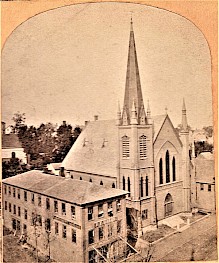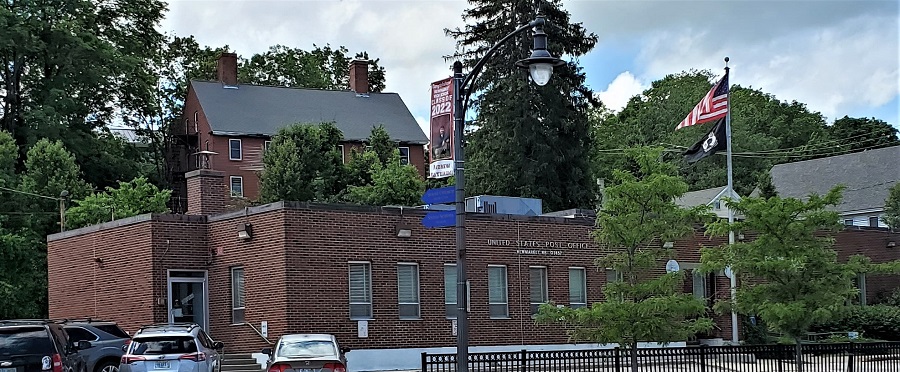


1913-1967 Before the Post Office, there was a block of three buildings sandwiched between Chapel and Church Streets. To get some perspective on the history of this block, keep in mind that this area was likely orchard land until NMCo came along, prompting Arthur Branscomb to move his tavern uphill away from the wharf area. His store, his tavern, and his home — all lined this block for up until a decade before the Civil War. How the street changed:
 1. On the north corner of Church and Main, an 1857 map shows “Haley’s Tailoring” (a supplier of Union uniforms during the Civil War). This was the three-story building that replaced the Branscomb store.
1. On the north corner of Church and Main, an 1857 map shows “Haley’s Tailoring” (a supplier of Union uniforms during the Civil War). This was the three-story building that replaced the Branscomb store.
In the 1927-30 Newmarket Street and House Directory, this building housed “Joseph A. Brisson, groc and prov” and “Frederick Miles, bowling alleys”
2. On the south corner of Chapel and Main Branscomb’s house was demolished (probably during the 1860s), and the new owner Susan Creighton built the structure that stood for a century, serving as the post office from 1883 until 1903 (under Postmasters Green, Morse and Small). Previously, according to Nellie Palmer George in Old Newmarket, it had been:
owner Susan Creighton built the structure that stood for a century, serving as the post office from 1883 until 1903 (under Postmasters Green, Morse and Small). Previously, according to Nellie Palmer George in Old Newmarket, it had been:
“a boot and shoe store of William and George French. On the north side of the same building was the millinery store of Mrs. Mary Badger. She brought from Boston for use in her store the first window screens in town. They were of thin cloth with a landscape printed on them. One could see out, but no one could look in.”
In the 1927 street directory, this same building housed “The Great Atlantic & Pacific Tea Co., Felix Lavasseur, and Mrs. Leda Garneau, fancy dry goods.”
 3. Between these two buildings the old Branscomb’s Tavern remained until 1871, when the Methodist Church bought the land. The old 1800s-era tavern was moved to its present location up the street (Site No. 34). It holds the distinction of having been in three different places on Newmarket’s Main Street.
3. Between these two buildings the old Branscomb’s Tavern remained until 1871, when the Methodist Church bought the land. The old 1800s-era tavern was moved to its present location up the street (Site No. 34). It holds the distinction of having been in three different places on Newmarket’s Main Street.
At Look at What Used to Be: The Journey from Divinity to Diversion
The Newmarket Methodist Church was constructed in 1871, snuggled between Haley’s Tailoring and Susan Creighton’s new building. It was quite grand—often called the “Jewel of Newmarket”. Less than 40 years later (in 1907) it declared bankruptcy and its members joined the church across the street. It was not immediately determined what would be done with the building, and it continued under the ownership of the trustees of the church for several more years.
building. It was quite grand—often called the “Jewel of Newmarket”. Less than 40 years later (in 1907) it declared bankruptcy and its members joined the church across the street. It was not immediately determined what would be done with the building, and it continued under the ownership of the trustees of the church for several more years.
1907-1913: One possibility was for the town to purchase it for use as a larger town hall; but in March 1909, the town voted NO.
Bit by bit, its treasures were sold off. In March 1909, the pipe organ and bell were sold to St. Mary’s Society. For the next several years, the building was used for various functions.
Excerpts from The Newmarket Advertiser describe how the Jewel of Newmarket came to be the Star Theatre:
Jan. 17, 1913: “The trustees of the Methodist church have instituted foreclosure proceedings on the Methodist church property, now the Scenic Temple, which will be sold at public auction, Jan. 25, at 11 a.m. in front of the building.”
Jan. 31, 1913: “The Methodist church building which has been used as a moving picture theatre for several months was sold at auction last Sat. forenoon, by mortgagees’ sale, and was knocked down to the trustees of the church for $5700.”
March 1913 : “The Methodist Church, which hadn’t been used in the past 5 years, was sold to Messrs. Churchhill and Cardinal of Skowhegan, Me., and they altered it over into a moving picture and vaudeville theater. Mr. Cardinale moved to Newmarket to manage the business. Reported final cost of the sale was $5,000”. It was around this time that the name of “Scenic Temple,” and was being used to show motion pictures. When the movie theatre opened admission was ten cents. Their first advertisements did not mention the movie titles to be shown, but the public was assured that it would be a “repertoire of the highest-class Photo Plays.”
Bids were requested for remodeling and reconstruction. The management kept showing movies even during the alterations.
August 1913: The majestic steeple was removed.
Oct. 24, 1913: The old weathervane which had been on the steeple was regilded and placed on the roof of the new “Star Theatre”.
Downstairs held Turcotte’s hardware store and A.H. Place’s Drugstore. Donald Pelletier described the entry to the movies during the 1950s: “The middle entrance was the Star Theatre. I would walk up a steep staircase with a ticket booth at the top. After purchasing a ticket, I would go either right or left up another short set of stairs leading to the swing doors to the theatre entrance. There was a balcony, but I never got the chance to sit up there.”
—

—
During the Teens and Twenties (the silent era), there was live music played during the films. Bennie Kendrigan (the barber/musician up the street) and Mae Gordon often played—he the violin, and she the piano.

—
1917: As the country entered World War I, the Star Theatre announced, “The gross receipts at the Star Theatre for the week beginning October 22 will be used to buy Liberty Bonds. Every cent paid for admission during this week will help win the war.” Management continued to offer or host film events that supported some aspect of the war effort. Newsreels shared the latest war news. As can be seen in the ads, children got into matinees for 17 cents; adults paid 28 cents for both matinee and evening shows. Balcony seats (evening only) were 39 cents.
1929—Talkies! In February E.G. Pollard and his wife went to New York to make arrangements for “talking picture” installation at the Star Theatre. It would take a year to get to Newmarket.
Feb. 1930: “Manager James Pollard has announced that the installation of equipment for the presentation of talking pictures is being completed and this Friday he will present to Newmarket theatre-goers the all-talking picture “Flight,” with Jack Holt.” (Estimated cost: $5,000).
With the advent of the “talkies” Mae Gordon was no longer needed to provide music during the films. But she continued to play there regularly, according to a 2022 reminiscence of Shirley Roper Walker who, as a small child saw her play. It was particularly memorable because Mae suffered from St. Vitus Dance (a neuropsychiatric manifestation of rheumatic fever), which resulted in a fair amount of leaping about during her performance.
And there was air conditioning in the summertime…or what passed for air conditioning. Blocks of ice from Filion’s Ice House were set in front of large fans that circulated cool air up thru the vents in the floor.
For those who lived in town, going to the movies at the Star Theatre may have been taken for granted. Not so for the farm families who lived a couple miles out of the town center. One Saturday during the 1940s, Shirley and her sister Ollie had been given permission to walk to town to go to the movies—but they had to help a neighbor get her pigs penned up first. Poor Ollie severely injured her heel during that chore. It was several weeks before the girls finally got their movie treat—with Ollie hobbling up the stairs, supported by her father.
Singing for a Silver Dollar at the Star Theatre
For the judging, Santa stood behind the kids and held his hand over the head of each little performer while the audience applauded. The singer who got the loudest response would win! That day, little Billy Mitchell left the Star Theatre one dollar richer.
|
The Star Theatre continued entertaining townsfolk through the Depression and World War II. There was something for everyone: newsreels informed, cartoons delighted, and romances inspired more than one furtive first kiss. The venue was also used for high school graduations, baccalaureate ceremonies and group celebrations of all sorts. Children’s Christmas celebrations were held there featuring Santa, movies, candy, small gifts, and talent shows.
Downstairs continued to house retail establishments. At one point there was a Gulf station with two gas pumps out front.
1951-52: Arthur J. Turcotte owned the Star Theatre, employing Edward Dondero as machine operator. By April 1952 the theatre closed due to insufficient attendance. Several veterans decided to step in and rescue the movie theatre (at least on weekends), especially for the younger generation.
1953-54: VFW President George Pelletier (a POW in WW II) and Charles Marelli decided to establish and operate weekend matinees for the kids. Joined by father and son Lauris D. and T.Sgt. I.G. Glidden, they each donated $25 to start the venture. The first feature was “Fair Wind to Java” starring Fred MacMurray.
During those couple of years, Newmarket youngsters and their parents took full advantage. Many youngsters lived within easy walking distance and could scrounge the money (15-17 cents) for an afternoon at the movies. And parents also took advantage of the family friendly offerings—complete with popcorn and Raisinets. There were lots of Westerns, but movies such as Bambi were shown as well. And Barbara Pelletier remembers seeing Our Lady of Fatima with her mother.
George Pelletier’s nephew Donald recollects:
The matinee consisted of two cartoons, usually Bugs Bunny, etc. and the Three Stooges. My father would give me a quarter. I would stop at Blanchette’s Bakery, buy five one-day-old donuts for a nickel, and then pay 17 cents for the movie. I don’t remember if I kept the 3 cents or returned it to my father. A quarter was a fair amount of money back then but was a bargain for my parents to get rid of me for a few hours.
The feature film was a western, my favorites being Randolph Scott, Gene Autry and Roy Rogers. After the movie I would go to the woods behind my house and play cowboys and Indians.


Newmarket’s downtown movie theatre closed for good on May 29, 1954.
There was talk of commercial renovation of the building. But it was just talk.
No attempt was made to remove the old “STAR” marquee—giving the 1950s thru the mid ’60s a seedy blighted look on Main Street.
A.J. Turcotte made no attempt to improve the functionality 0r look of his hardware store. He installed gasoline pumps on the edge of the sidewalk, all the while complaining loudly of how high taxes were driving business away. Color TV became popular in the mid 1950’s, and Arthur had one playing in his front window at the hardware store, which always drew an audience.
He saw there was more money in selling color televisions, than selling movie tickets. Arthur died in 1957 and his son Romeo “Barney” Turcotte ( a WW II Army/Air Force Vet) ran the business until 1965 when he sold the building.
Until 1966 the broken marquee remained a focal point of the old three wooden buildings crammed between Church and Chapel Streets.
—-
the new Federal Post Office as spearheaded by Post Master and WW II Veteran Arthur “Baldy” Beauchesne. The Newmarket Woman’s Club directed the landscaping of the grounds.
